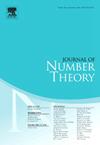Dirichlet l -函数在q方面的大偏差的上界
IF 0.6
3区 数学
Q3 MATHEMATICS
引用次数: 0
摘要
我们证明了具有给定模的偶原始狄利克雷l函数中心值的大偏差的一个结果。V∼α日志日志问0 & lt;α& lt; 1中,我们显示that1φ(q) #{χ甚至原始mod问:日志| L(χ,12)|祝辞V}≪e−V2log日志qlog日志q。这得到了由Gao证明的Dirichlet l -函数中心值的分数阶矩的明显上界,注意到模数为q的偶数原始字符的数目为φ(q)2+O(1)。该证明是对由Arguin, Bourgade和Radziwiłł为黎曼zeta函数的局部最大值而开发的递归格式的q方面的适应,并由Arguin和Bailey应用于t方面的大偏差。我们进一步求出V=o(log log)时的边界。这些边界并不会很明显,但是与中心极限定理估计的差异随着q的增长非常缓慢。该方法涉及Dirichlet l -函数中心值的扭曲缓和第二矩的公式,建立在Iwaniec和Sarnak的工作基础上。本文章由计算机程序翻译,如有差异,请以英文原文为准。
Upper bounds on large deviations of Dirichlet L-functions in the q-aspect
We prove a result on the large deviations of the central values of even primitive Dirichlet L-functions with a given modulus. For with , we show that This yields the sharp upper bound for the fractional moments of central values of Dirichlet L-functions proved by Gao, upon noting that the number of even, primitive characters with modulus q is . The proof is an adaptation to the q-aspect of the recursive scheme developed by Arguin, Bourgade and Radziwiłł for the local maxima of the Riemann zeta function, and applied by Arguin and Bailey to the large deviations in the t-aspect. We go further and get bounds on the case where . These bounds are not expected to be sharp, but the discrepancy from the Central Limit Theorem estimate grows very slowly with q. The method involves a formula for the twisted mollified second moment of central values of Dirichlet L-functions, building on the work of Iwaniec and Sarnak.
求助全文
通过发布文献求助,成功后即可免费获取论文全文。
去求助
来源期刊

Journal of Number Theory
数学-数学
CiteScore
1.30
自引率
14.30%
发文量
122
审稿时长
16 weeks
期刊介绍:
The Journal of Number Theory (JNT) features selected research articles that represent the broad spectrum of interest in contemporary number theory and allied areas. A valuable resource for mathematicians, the journal provides an international forum for the publication of original research in this field.
The Journal of Number Theory is encouraging submissions of quality, long articles where most or all of the technical details are included. The journal now considers and welcomes also papers in Computational Number Theory.
Starting in May 2019, JNT will have a new format with 3 sections:
JNT Prime targets (possibly very long with complete proofs) high impact papers. Articles published in this section will be granted 1 year promotional open access.
JNT General Section is for shorter papers. We particularly encourage submission from junior researchers. Every attempt will be made to expedite the review process for such submissions.
Computational JNT . This section aims to provide a forum to disseminate contributions which make significant use of computer calculations to derive novel number theoretic results. There will be an online repository where supplementary codes and data can be stored.
 求助内容:
求助内容: 应助结果提醒方式:
应助结果提醒方式:


